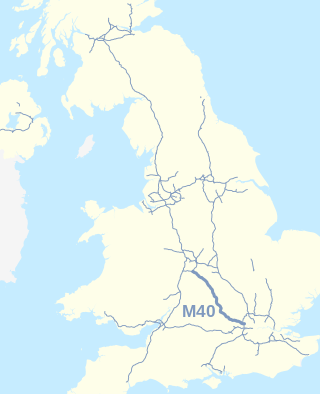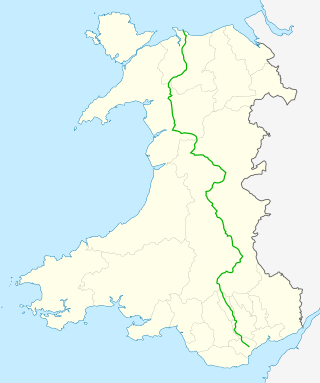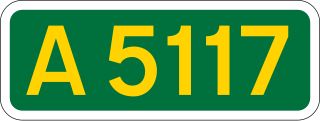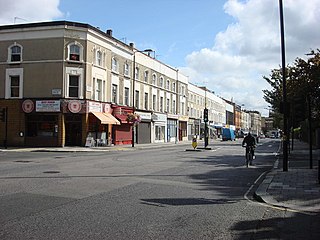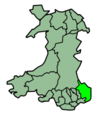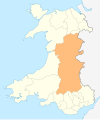Abergavenny – Carmarthen
At Abergavenny is the A40 junction with the Heads of the Valleys road, (A465) and the A4042. Now the A465 becomes the primary route between the Midlands to the South Wales Valleys and Swansea; there is a dual-carriageway route to Carmarthen via the A465, M4 and A48.
The A40 becomes single carriageway and continues through Abergavenny, following the north side of the Usk valley through the eastern part of the Brecon Beacons National Park until Brecon. At Bwlch between Abergavenny and Brecon, the A40 is 660 feet (200 m) above sea level. The A40 is dualled for over 1.5 miles (2.4 km) as it approaches a junction east of Brecon with the A470 north, which is the main north–south road through mid-Wales. Continuing as a dual carriageway, the A40 and A470 concurrent bypass Brecon to the south, crossing the River Usk here. At the western end of the bypass is a further junction with the A470 south. Beyond this point the A40 continues as a single carriageway, now south of the River Usk, and roughly follows the northern edge of the Brecon Beacons National Park. A height of 820 feet (250 m) above sea level is located less than 1 mile (1.6 km) east of Trecastle. In Llandovery the road crosses the Heart of Wales railway and the River Tywi; the road, railway and river then run parallel until Llandeilo, where the National Park ends and the railway turns south. The A40 continues west along the Tywi valley to Carmarthen where as a dual carriageway it forms the eastern bypass, meeting the terminus of the A48 at Pensarn. Here the A40 returns to being a primary route westwards.
Carmarthen – Fishguard
At Carmarthen the A40 crosses the River Tywi twice with two 90-degree junctions and continues on 10 miles (16 km) of dual carriageway as far as St. Clears, where the dual carriageway ends at the junction with the A477 trunk road. Now the A40 is a mixture of 2 or 3 lane single-carriageway to Haverfordwest and Fishguard. This section of road is controlled by the Welsh Government (formerly 'Welsh Assembly Government'), which describes it as "one of the lowest standard sections of the Trans European Road Network in the United Kingdom". [5]
St Clears to Haverfordwest dualling There were plans in 2002 for a major improvement of the 23-mile stretch between St Clears and Haverfordwest which included upgrading to a dual carriageway; described as an extension of the national motorway network to the West Wales coast by virtue of the route from the M4 motorway being entirely dual carriageway. [6] The £60 million scheme was subject to a European Environmental Assessment. Within a couple of years, the project appeared to be dying a very quiet death, causing local newspapers to report it being an election stunt for the two marginal constituencies that would best benefit from the improvements. The following Welsh elections saw both constituencies change the party of majority. The political party at the centre of the row instead directed the project deferment to damning environmental statements by Friends of the Earth Cymru. [7] [8] The scheme was officially scrapped in 2008 after a Welsh Assembly committee decided to abandon the proposals. Instead, it recommended upgrades to the existing route including bypasses around Robeston Wathen and Llanddewi Velfrey using a three-lane option. This was welcomed by the Friends of the Earth, saying "The dual carriageway on the A40 would increase traffic levels, increase the emission of greenhouse gases, it would be harmful for the environment, it would be hugely expensive. That money would be better spent on improving public transport, on health, on education, there's no need for it. We think the assembly committee has come to the right decision". [9]
Whitland Bypass The last improvement to the A40 on this section prior to the Welsh Assembly Government having the devolved responsibility for this road was a 4.1 kilometres (2.5 mi) £8 million bypass around Whitland. Constructed in 1994, the road started east of Black Bridge on the original A40, then running north of the town before to a new roundabout just west of Llain Cottage. The Secretary of State for Wales was asked a written question by Rhodri Morgan about adding a second carriageway to the Whitland bypass scheme, to which John Redwood replied "There are no proposals to add a second carriageway to the Whitland bypass. The design capacity of a single carriageway two-lane highway is more than adequate to cater with the anticipated traffic flows for the foreseeable future." [10]
Llanddewi Velfrey Bypass A new bypass has been granted approval by the Welsh Assembly Government at Llanddewi Velfrey in Pembrokeshire. The scheme would improve the A40 between Llanddewi Velfrey and Penblewin, to the west of St Clears and meet the aim of the targeted investment in infrastructure along the east–west road corridor in south Wales. [11] From the east, it is proposed that a roundabout would be created just north of Glenfield Farm, where the straight section from St Clears ends at Bethel Chapel, and then take a new route north-west of the town of Llanddewi Velfrey, south-west over Pentroydin Fawr and Penttroydin Fech farms with cattle underpasses, a new underpass beneath the existing Llanddewi Velfrey to Llanfallteg road, before going over the original A40 at Ffynnon Wood. To the west of Ffynnon Wood, the road would then cross back over the original A40 to the east of Henllan Lodge in a way to maintain the tree lined avenue to Henllan, then run parallel to the A40 on the north side of the existing A40 to a new roundabout at Penblewin and the junction with the A478. [12]
This was originally known as the Blue and Purple routes during the Consultation in 2006 [13] for which 75% preferred the blue route, and only 20% preferred the red route. 54% felt the section from Ffynnon Wood and Penblewin Roundabout needed improvement, with both orange and purple routes preferred by 42% of the respondents. Welsh Water/Dwr Cymru expressed concerns with the red route affecting water mains and sewers, and Henllanfallteg Community Council felt the red route would not improve the quality of life in Llanddewi Velfrey. Pembrokeshire County Council expressed concerns that the route planned was a single carriageway, and that within seven years, a dual carriageway would be required.
Robeston Wathen Bypass A new bypass has been constructed between Penblewin and Slebech Park making the road straighter and with a '2+1' road layout to help improve overtaking opportunities. [14]
Starting to the west of Toch Lane (approx. 2 kilometres (1.2 mi) east of Slebech), the route travels eastwards for 4.6 kilometres (2.9 mi), passing 200 metres (660 ft) south of Robeston Wathen, and ending 0.5 kilometres (0.31 mi) east of the village, just west of Flimstone Lane.
Construction started on the route in February 2009, with the works completed and the new road opening 1 March 2011. The road was built by Costain. The scheme was nearly £14 million over the initial budget of £27.6 million, eventually costing £41.4 million. The Welsh Assembly Government explains this increase as being the result of inflation and land costs, saying the original budget did not include either, as well as additional statutory procedures, additional works following some design standards, and the increase in VAT. [15]
The Kell The Kell is located on a section of the A40 that forms a north–south corridor between Fishguard, 17 kilometres (11 mi) to the north and Haverfordwest, 7.5 kilometres (4.7 mi) to the south, close to Treffgarne and Spittal. The improvement saw about 0.48 kilometres (0.30 mi) of new trunk road commencing at a point on the trunk road approximately 622 metres south of the centreline of the junction of the A40 trunk road with the C3059 road to Spittal and extending in a generally northerly direction to a point approximately 112 metres south of the junction of the trunk road with the C3059 road to Spittal. [16] This resulted in the road being rerouted through pasture to the east of the original road, taking a right hand bend about 160 metres (520 ft) south of The Old Mill, taking a 5.5% gradient, and rejoining the original road 210 metres (690 ft) north of The Kell. The original road has subsequently been converted to an access road for The Old Mill, Beavers Lodge and The Kell, accessing the new road at The Old Mill.
Fishguard Bypass The Fishguard Bypass was planned to provide a more direct route with greater capacity to the Port of Fishguard at Goodwick avoiding the town centre of Fishguard. It was constructed during the late 1990s and opened in 2000. It takes the form of a three-lane carriageway on an approx. 10% gradient around the western edge of Fishguard. It runs from its highest point at Rafael roundabout 1 km south of Fishguard town in a generally northerly direction to its lowest point at Windy Hall roundabout where it rejoins the old A40 route at Gasworks Hill. The bypass is concurrent with a section of the A487 trunk road with the A40 dominant. [17] [18]










